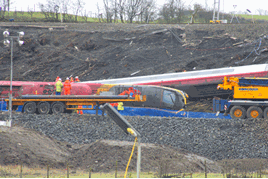While it is important to inform interested parties about what has happened, the main value of an RAIB investigation (which justifies the resources put into it) lies in its potential to make the future railway safer. This safety learning can even come from events that at first sight may appear trivial, or from the actions of people not connected to the railway.
For instance, in 2013, a collision between a train and a car at Jetty Avenue level crossing (Woodbridge) did not result in any personal injury. However, the RAIB investigation found that at this level crossing, safety relied on users looking out for approaching trains. Many motorists did not understand how they were supposed to use the crossing, while Network Rail did not understand how motorists were actually behaving and how limited the view of approaching trains actually was.
The resulting recommendations seek to achieve fundamental changes in the way that safety is managed at user-worked level crossings, which currently represent one of the biggest contributions to risk on the railways.
After the decision to investigate has been made, the next step is to let the wider world know of RAIB’s intended actions. This involves drafting a website entry (which often starts the ball rolling for what will later appear in the press and on internet news sites), and letting interested parties know what information is going to be released. The RAIB wants, in particular, to make sure that injured and bereaved people know that their accident is going to be the subject of wider attention, before the details are made public.
When things need putting right in a hurry, the RAIB needs to act fast. If the work on site has uncovered a serious problem with a piece of equipment or an operating practice, the Branch can issue urgent safety advice, either to the industry or just to the companies directly affected.
Such advice can also be used to summarise the RAIB’s emerging findings, at a later stage in the investigation. And when this advice is sent out, it appears in the final report for reference. So far, this process has been invoked 31 times, for issues ranging from the design of the switches involved in the derailment at Grayrigg (see case study, page 57) to the details of cotter pins on steam locomotives.
As an investigation progresses, evidence is gathered and analysed. Regular reviews are held to confirm that the right evidence is being collected, and that the analysis is correct. Where there are technical issues, it’s likely that testing will take place. Additional interviews with people who have information about what happened also help fill in the gaps in the investigators’ knowledge.
Peer review is a vital and hugely valuable part of the process, and takes place at several levels, up to the final analysis review with the chief inspector. At each stage the investigator is challenged to justify the conclusions they have drawn and the recommendations they are proposing.
During and after the analysis review process, the report is being written. It too has to survive peer review at several levels, and only once the chief inspector is happy with it can it be released for consultation. This process happens in the weeks running up to publication of the report, and is a stage required by law. It is seen by the Branch as an important opportunity for the people and organisations that have an interest in the investigation to have their say.
The investigation team will contact each of the organisations that are likely to be affected by any recommendations, as well as the injured or bereaved, to share with them what the RAIB has found and what it intends to say in the report. Just as importantly at this stage, it provides some much-needed answers for injured parties and bereaved families. The formal consultation then gives each party sight of the draft report, and two weeks to comment on it.
All this should mean that any errors are picked up before publication, and any doubts about whether recommendations are desirable or practicable can be dealt with. Once all the comments from the consultation process have been considered (in some cases, changes to the report can mean that a re-consultation is required), the final text is submitted to the Secretary of State for Transport, and published on RAIB’s website three days later.
Since its inception, the RAIB has made a total of 1,330 recommendations, covering aspects across the entire industry. Almost all of these have been addressed to the Office of Rail and Road, which confirms that around 95% of recommendations have been implemented, showing the very real difference the investigative work of the Branch is making.
“The RAIB has come a long way in its first ten years,” says Acting Chief Inspector Simon French. “I am really proud of what we have achieved to date, the professionalism of the team, and our important contribution to making the UK’s railway among the safest in Europe.”
The Branch is also striving to further improve the service it provides to the industry. While it says it will never compromise on quality, it is determined to find more effective ways to communicate its findings to the public and the industry.
Each year it publishes an Annual Report (this year’s was published in August), which lists the recommendations made to the industry and the action that has been reported to implement them.
Over the course of its first ten years, the RAIB has shone a light onto the minutiae of railway operations, to uncover the weaknesses that hinder safe working. While it is sometimes uncomfortable for the individuals and companies involved to come under such close scrutiny, it is done without judgement and becomes the catalyst for significant safety improvements.
- This feature was published in RAIL 786 on October 28 2015













Login to comment
Comments
No comments have been made yet.